Chapter 20: Romanticism
Key Notes
- Time Period: 1789–1848
- Culture, beliefs, and physical settings
- Europe and the Americas experience great innovation in economics, industrialization, war, and migration. There is a strong advancement in social issues.
- Artists in the Romantic period interpreted Enlightenment values in a new light.
- Cultural interactions
- Architecture is expressed in a series of revival styles.
- Artists are exposed to diverse, sometimes exotic, cultures as a result of colonial expansion.
- Material Processes and Techniques
- Architecture is affected by new materials and new modes of construction.
- Artists use new media including photography, lithography, and mass production.
- Audience, functions, and patron
- Commercial galleries become important. Museums open and display art. Art sells to an ever-widening market.
- The Salon in Paris retains its leading role in the display of art.
- Women artists become increasingly important.
- Theories and Interpretations
- Audiences and patrons were often hostile to art made in this period.
- Art history as a science continues to be shaped by theories, interpretations, and analyses applied to these new art forms.
Historical Background
- The French Revolution inspired freedom movements worldwide
- Despite good intentions, the revolution turned chaotic with Reign of Terror and Napoleonic Wars
- Philosophical ideas from the revolution had long-term positive impact on Europe, embodied in the Romantic spirit
- Romantics valued social independence, freedom of thought, and open self-expression
- These values influenced political battles, education, social welfare, and the arts
- Romantics reacted against Enlightenment, advocating for trusting the heart over the head.
Patronage and Artistic Life
- Romantic artists were highly sensitive, critical, and often exhausted
- They sought pleasure in refined things or audacious adventures, and were influenced by the extremes of human endeavor
- Many Romantic artists were loners who fought for important causes, such as Delacroix and Goya
- They often had a melancholic mindset, and championed the antihero
- Photography was the greatest artistic invention of the period, but was initially not seen as a form of art
- There were no academies or schools for photography, so marginalized populations, including women, easily entered the field
- School: a group of artists who share the same philosophy, work around the same time, but not necessarily together
- Some of the most important advances in photography were made by these groups, making it the first instance of equal opportunity in the arts.
Revival Architecture
- Nineteenth-century architecture was characterized by a revival of past styles due to historicism and nostalgia
- The Middle Ages were particularly popular due to a perceived increase in devotion and sincerity
- Medieval ruins were so highly regarded that people had new ruins built for Romantic contemplation
- Other styles were also revived, including Egyptian, Islamic, and Baroque architecture
- Iron was increasingly used in architecture, often hidden in Gothic or Romanesque styles, but also exposed in progressive designs
- Ironwork was valued for its elegance and malleability, especially when combined with glass walls.
➼ Palace of Westminster (Houses of Parliament)
Details
- By Charles Barry and Augustus Pugin
- 1840–1870
- Made of limestone, masonry, and glass
- Found in London
Function
- The building holds the two chambers of the United Kingdom’s government:
- the House of Commons and the House of Lords
- Today, the House of Lords is largely a ceremonial body.
Form
- Enormous structure of 1,100 rooms, 100 staircases, 2 miles of corridors.
- It is a modern office building cloaked in medieval clothes.
- Barry, a classical architect, accounts for the regularity of plan.
- Pugin, a Gothic architect, added Gothic architectural touches to the structure.
- The profusion of Gothic ornament (pinnacles, spires, vertical thrust) is greater than would appear in an original Gothic building.
- Modern adaptation of a Gothic building includes innovations like air ventilation shafts.
Context
- Competition held in 1835 for a new Houses of Parliament after the old one burned down in 1834.
- There were 97 entrants: 91 in the Perpendicular Gothic style and 6 in the Elizabethan style; these styles were thought to be native English styles suitable for a new capitol building.
- Big Ben is a clock tower; in a sense a village clock for all of England.
- The building is a reaction against art as a mass-produced product of the Industrial Revolution; it has a hand-crafted look.
Image
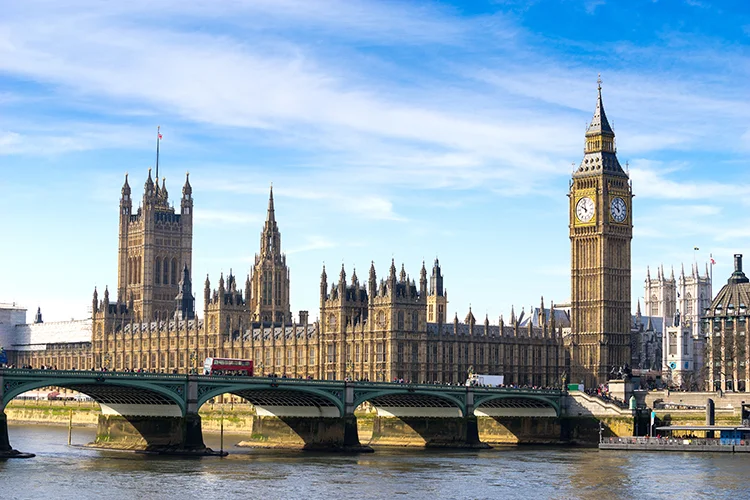
Central Lobby
Situated between the House of Commons and the House of Lords.
Meant to be a space where constituents can meet their member of Parliament.
The metal grilles on the doorways were originally in the House of Commons and marked off the spots where women could be seated to watch Parliament; now they are symbols of the suffrage movement.
The grilles, originally installed to ensure that members of Parliament were not distracted by the sight of women watching them at work, were finally removed permanently from the gallery and placed in the Central Lobby following a vote in the House of Commons in August 1917.
The central octagonal space contains statues of the kings and queens of England and Scotland.
Four large mosaics, one over each doorway; in each mosaic a saint represents a different area of the United Kingdom:
- England: Saint George.
- Scotland: Saint Andrew.
- Wales: Saint David.
- Northern Island: Saint Patrick.

Westminster Hall
When the old Houses of Parliament burned to the ground, this hall survived and became the last vestige of the medieval parliament building.
Perpendicular Gothic style of Westminster Hall inspired the design of the Houses of Parliament.
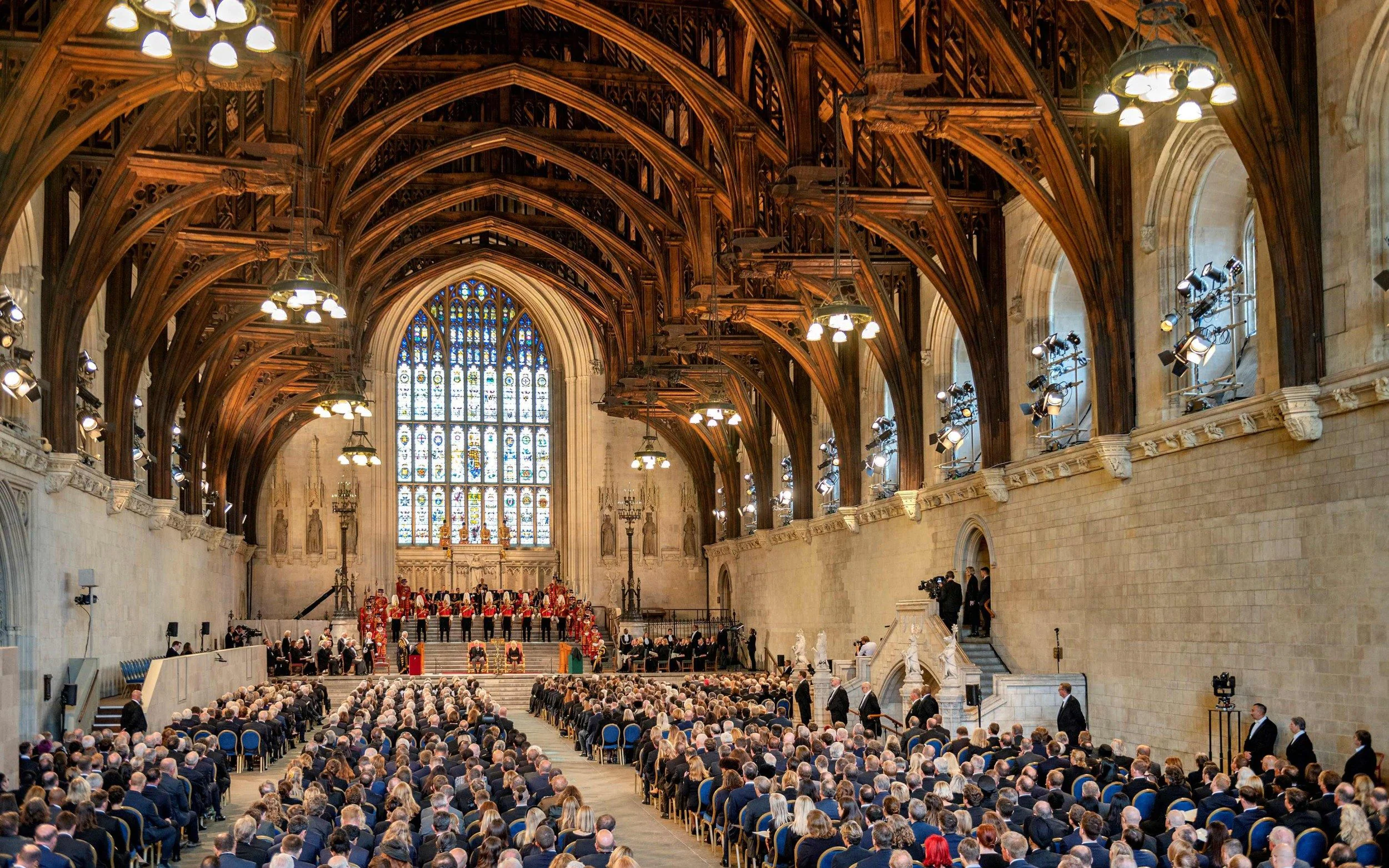
Romantic Painting
- The Romantic artists were fascinated by the sublime in art and rejected the Enlightenment's idea of beauty as ordered and scientific.
- The sublime: any cathartic experience from the catastrophic to the intellectual that causes the viewer to marvel in awe, wonder, and passion
- They sought to create art that depicted the fantastic, the unconscious, the haunted, and the insane.
- Photography had a significant impact on painters, with some abandoning painting, while others saw it as a valuable tool.
- Artists were also caught up in political movements such as the fight for Greek independence, and political paintings became important.
- Landscape painters also had a political agenda, with some using their art to express their opposition to the Industrial Revolution or to respond to criticism about environmental pollution.
➼ And There’s Nothing to Be Done (Y no hai remedio)
Details
- By Francisco De Goya
- from The Disasters of War (Les Desastres de la Guerra), Plate 15
- 1810–1823 (published 1863)
- Made from etching, drypoint, burin, and burnishing
- Found in Metropolitan Museum of Art, New York
Context
- Original title: “Fatal Consequences of Spain’s Bloody War with Bonaparte and Other Emphatic Caprices.”
- Caprice: usually a work of art that is an architectural fantasy; more broadly any work that has a fantasy element
- Drypoint: an engraving technique in which a steel needle is used to incise lines in a metal plate. The rough burr at the sides of the incised lines yields a velvety black tone in the print
- Artwork was critical of the French occupation of Spain and the subsequent Spanish rulers.
- Influenced by Spain’s continuous warfare.
- Eighty etchings and aquatints.
- Published in 1863, 35 years after the artist’s death.
- Explores themes of war, famine, and politics.
Technique
- Goya used a combination of etching and drypoint.
- Etching gives the work fine details.
- Drypoint is added to the metal etched plate.
- The rough burr at the sides of the incised lines yield a velvety black tone in the print.
- The effect is a very rich black and white surface.
And There’s Nothing to Be Done
- Bitterly ironic and sardonic.
- Guns at very close-range point toward the victims, assumedly Spanish patriots, who will be summarily killed by French soldiers.
- The mangled body on the ground accentuates the sense of despair.
- Are civilians or soldiers being shot? Ambiguity intentional.
- Central figure is seen in a Christ-like pose.
- Compositional elements reference Goya’s painting called The Third of May 1808.
Image
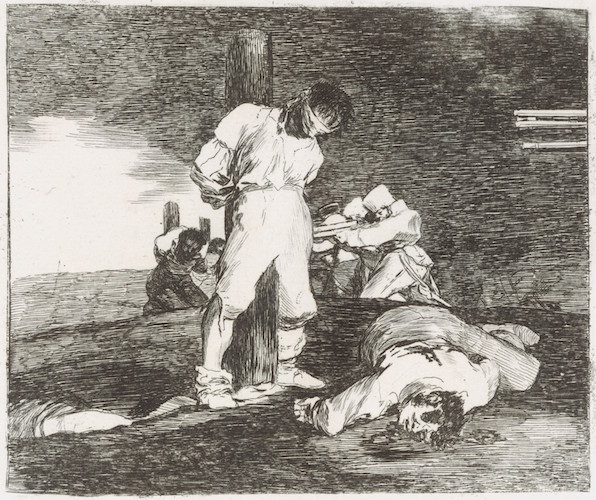
➼ La Grande Odalisque
Details
- By Jean-Auguste-Dominique Ingres
- 1814
- Oil on canvas
- Found in Louvre, Paris
- Odalisque: a woman slave in a harem
Form
- Inconsistent arrangement of limbs: rubbery arm, elongated back, odd placement of leg, one arm longer than other.
- Mannerist-like elegant distrortions.
- Raphael-like face.
- Not a traditional frontal nude.
Patronage and Reception
- Commissioned by Caroline Murat, Napoleon’s sister, Queen of Naples.
- Exhibited at the Salon of 1819; the critics did not understand Ingres’s style; he was criticized for his disregard for anatomical reality, a trait that set him apart from his teacher, Jacques-Louis David.
Context
- Turkish elements: incense burner, peacock fan, tapestry-like turban, hashish pipe; expresses an exoticism; Orientalism was a form of exoticism.
- Heavily influenced by Italian Mannerism in the figure style; perhaps the decorative motifs were influenced by Persian illuminated manuscripts.
Image
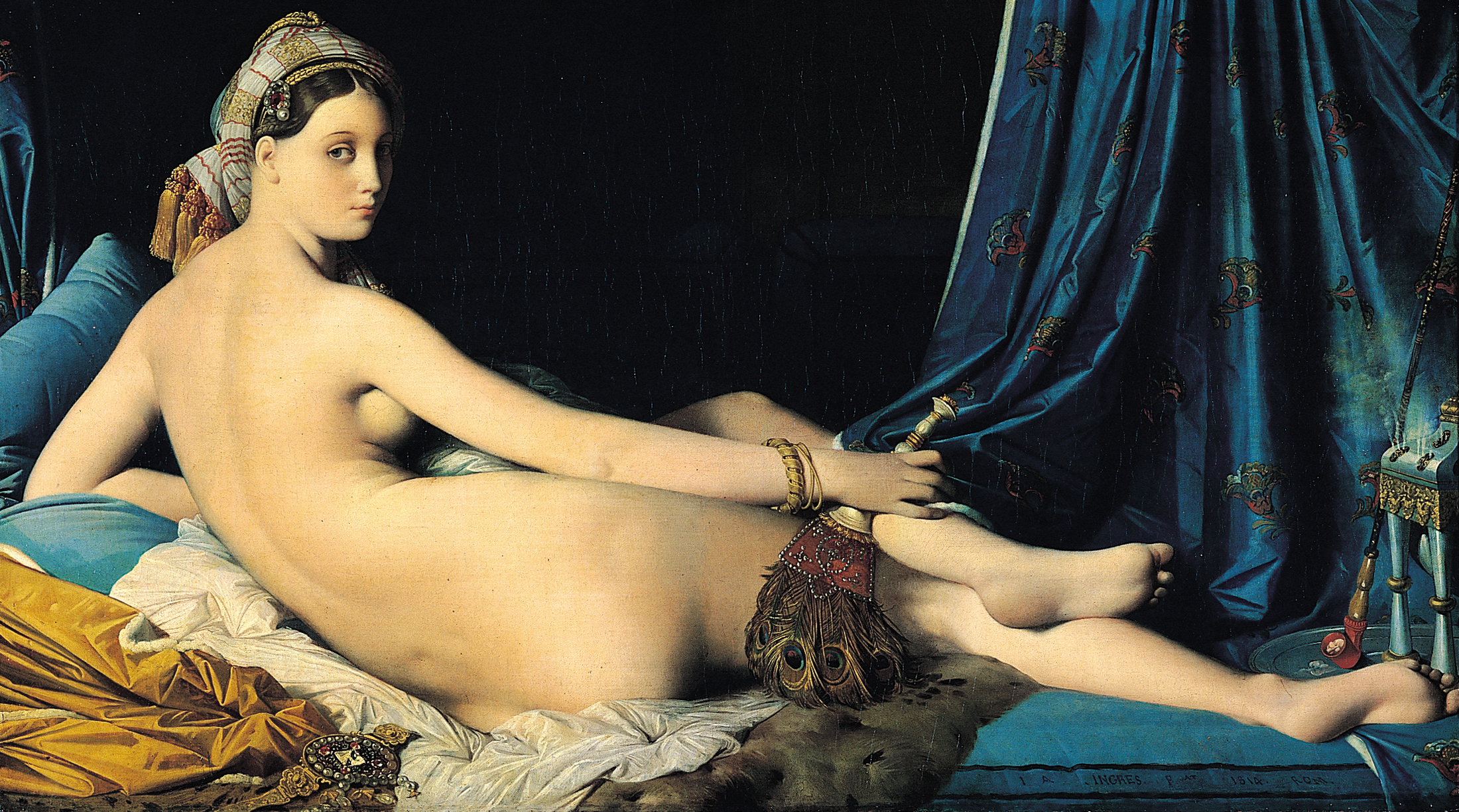
➼ Liberty Leading the People
Details
- By Eugène Delacroix
- 1830
- Oil on canvas
- Found in Louvre, Paris
Form
- Strong pyramidical structure.
- Red/white/blue (colors of the French flag) echo throughout the painting.
Content
- Liberty, with breast exposed and wearing no shoes, charges symbolically over the barricades.
- Liberty wears a red Phrygian cap, worn in the ancient world by freed slaves; portrayed as rebellious, vibrant, and fiery; she references the French Revolution of 1789.
- Notre Dame Cathedral is seen through the smoke on the far right; the French tricolor is raised on its tower.
- The Parisian landmark of Notre Dame is mixed in with the true historical event and the allegorical and symbolic figures.
Context
- The painting symbolically depicts the July Revolution of 1830;
- Liberty with the French tricolor in her hand marches over the barricades to overthrow government soldiers.
- The painting memorializes the overthrow of the French government of Charles X, the last Bourbon king of France, in favor of the “citizen king” Louis-Philippe.
- The child with pistols symbolizes the role of students in the revolt;
- the middle class is represented by a man with a top hat and carrying a rifle;
- the lower classes are symbolized by the man at extreme left with a sword in his hand and a pistol in his belt.
History
- Exhibited at the Salon of 1831 and then acquired by the French state
- Not exhibited publicly for twenty-five years because of its subversive message.
Image
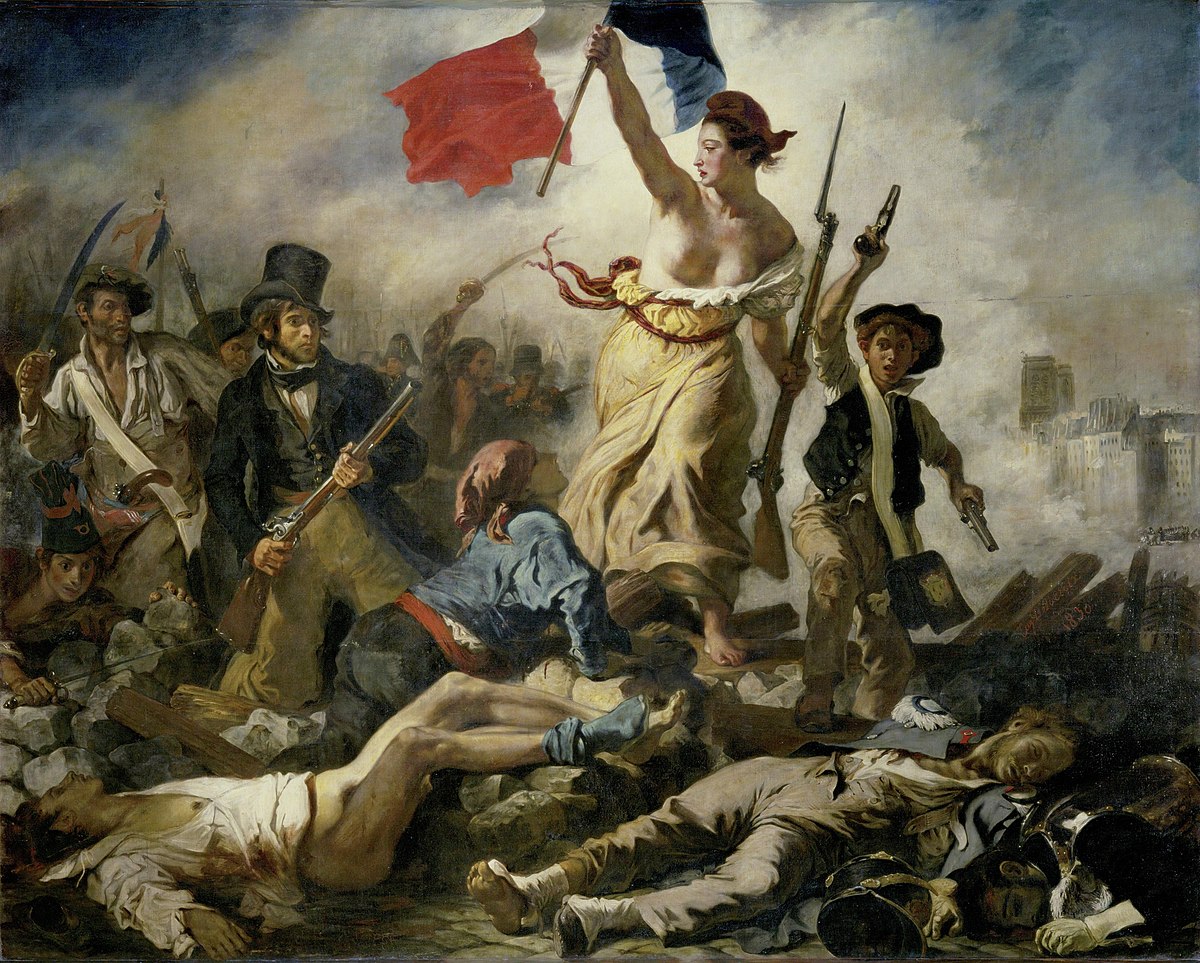
➼ Slave Ship
Details
- By Joseph Mallord William Turner
- Slavers Throwing Overboard the Dead and Dying, Typhoon Coming On
- 1840
- Oil on canvas
- Found in Museum of Fine Arts, Boston
Form
- Color expresses emotions.
- Rapid brushwork.
- Recognizable forms—the ship, the hands, the chains—are reduced in size and pale in comparison with the mightiness of the turbulent seascape.
- The bloody sunset acts as a symbol of the scene taking place.
- Use of the sublime enhances dramatic impact.
Context
- Exhibited at the Royal Academy in 1840, with an excerpt from Turner’s own poem called “The Fallacies of Hope:”
- “Aloft all hands, strike the top-masts and belay; \n Yon angry setting sun and fierce-edged clouds Declare the Typhon’s coming. \n Before it sweeps your decks, throw overboard \n The dead and dying—ne’er heed their chains \n Hope, Hope, fallacious Hope! \n Where is thy market now?”
- Based on a true story, an event in 1781 in which a slave ship, the Zong, sailed for the Americas full of slaves.
- The slaves were insured against accidental drowning, but not insured against sickness; a policy instituted to force captains to treat slaves humanely.
- Knowing that he would not collect insurance money on sick and dying slaves, the captain cast them overboard.
- Turner’s painting was inspired by an account of the scandal published in a book by Thomas Clarkson, which had been reprinted in 1839.
- England freed the slaves in 1833 by an act of Parliament, however, there were exceptions, which were not addressed until 1843.
- Nature responds to the inhumanity of the slave trade.
Image

➼ The Oxbow
Details
- By Thomas Cole
- The View from Mount Holyoke, Northampton, Massachusetts, after a Thunderstorm
- 1836
- Oil on canvas
- Found in Metropolitan Museum of Art, New York
Form
- Actual view in Massachusetts.
- Landscape divided into two clearly contrasting areas: the Romantic landscape on the left and the Classical landscape on the right.
- On the right, man’s touch is light: cultivated fields, boats drifting down the river.
Function
- Painted as reply to a British book that alleged that Americans had destroyed a wilderness with industry.
- Painted for an exhibit at the National Academy of Design; hence the unusually large size.
Context
- Illustrates the nineteenth-century American belief in Manifest Destiny.
- Cole is the founder of the Hudson River School.
- Cole’s self-portrait can be seen in the foreground in a dense forest.
- The wild landscape includes broken trees and a storm: the sublime.
- Cole at the center of the composition, between the two worlds expressed in the painting; challenges Americans to be good stewards of the land.
Image
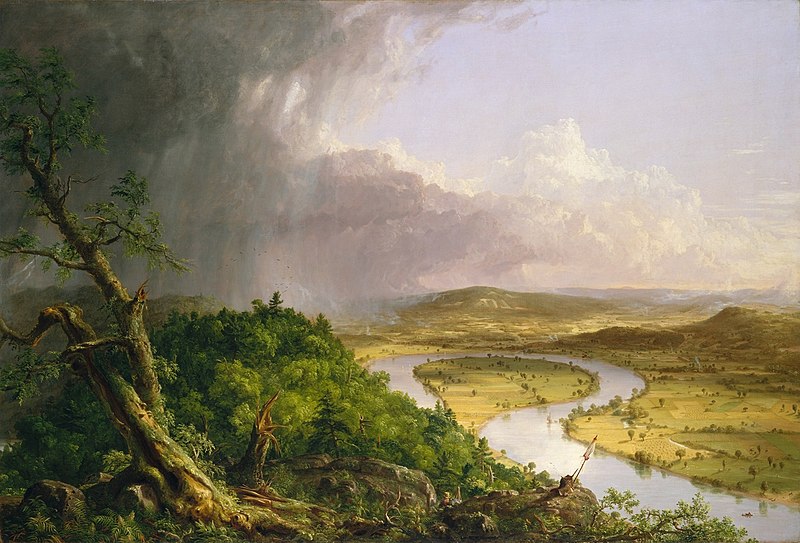
The Development of Photography
- Experiments in photography go back to the seventeenth century, when artists used a device called a camera obscura to focus images in a box so that artists could render accurate copies of the scene before them.
- Photosensitive paper: It was introduced that could replicate the silhouette of an object when exposed to light.
- Photogram: an image made by placing objects on photosensitive paper and exposing them to light to produce a silhouette
- Modern photography was invented in two different places at the same time: France and England.
- Daguerreotype: a type of early photograph, developed by Louis Daguerre that is characterized by a shiny surface, meticulous finish, and clarity of detail. Daguerreotypes are unique photographs; they have no negative
- Calotype: a type of early photograph, developed by William H. F. Talbot that is characterized by its grainy quality. It is considered the forefather of all photography because it produces both a positive and a negative image
- Both men showed their inventions to scientific conventions in January 1839.
- Photography spread quickly, and technological advances followed almost as fast.
- The advantages to photography were obvious to everyone: It went everywhere a person could go, capturing and illustrating everything from the exotic to the commonplace.
➼ Still Life in Studio
- Details
- By Louis-Jacques-Mande Daguerre
- 1837
- Daguerreotype
- French Photographic Society, Paris
- Form
- Photograph reproduces a variety of textures: fabric, wicker, plaster, framed print, etc.
- Inspired by painted still lifes, such as vanitas paintings.
- Context
- New art form proclaimed while referencing older art forms.
- Daguerreotypes have a shiny surface and a sharp eye for detail.
- No negative; therefore, copies could not be made.
- Long exposure times required.
- Produced on a metallic surface; photos have a glossy finish.
- Image \n